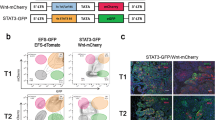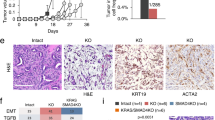Abstract
The ability of tumor cells to metastasize is increasingly viewed as an interaction between the primary tumor and host tissues. Deletion of the p19/Arf or p53 tumor suppressor genes accelerates malignant progression and metastatic spread of 7,12-dimethylbenz(a)anthracene (DMBA)/12-O-tetradecanoyl-phorbol-13-acetate (TPA)-induced squamous cell carcinomas, providing a model system to address mechanisms of metastasis. Here, we show that benign pre-metastatic papillomas from wild-type mice trigger lymphangiogenesis within draining lymph nodes, whereas there is no growth of primary tumor lymphatic vessels. Lymph node lymphangiogenesis is greatly accelerated in papilloma-bearing p19/Arf- or p53-deficient mice, which coincides with the greater propensity of these tumors to progress to carcinomas and to metastasize. The extent of accumulation of B cells within the tumor-draining lymph nodes of wild-type mice predicted the level of lymph node lymphangiogenesis and metastatic potential. Arf or p53 deficiency strongly accelerated lymph node immune cell accumulation, in a manner that was associated with the extent of lymph node lymphatic sinus growth. This immune cell accumulation and lymph node lymphangiogenesis phenotype identifies host anti-tumor responses that could drive metastatic spread of cancers via the lymphatics.
This is a preview of subscription content, access via your institution
Access options
Subscribe to this journal
Receive 50 print issues and online access
$259.00 per year
only $5.18 per issue
Buy this article
- Purchase on Springer Link
- Instant access to full article PDF
Prices may be subject to local taxes which are calculated during checkout







Similar content being viewed by others
References
Achen MG, Stacker SA . (2006). Tumor lymphangiogenesis and metastatic spread—new players begin to emerge. Int J Cancer 119: 1755–1760.
Ajiro K, Yoda K, Utsumi K, Nishikawa Y . (1996). Alteration of cell cycle-dependent histone phosphorylations by okadaic acid. J Biol Chem 271: 13197–13201.
Angeli V, Ginhoux F, Llodra J, Quemeneur L, Frenette PS, Skobe M et al. (2006). B cell-driven lymphangiogenesis in inflamed lymph nodes enhances dendritic cell mobilization. Immunity 24: 203–215.
Baldwin ME, Stacker SA, Achen MG . (2004). Molecular control of lymphangiogenesis. Bioessays 24: 1030–1040.
Brown DM, Fisher TL, Wei C, Frelinger JG, Lord EM . (2001). Tumours can act as adjuvants for humoral immunity. Immunology 102: 486–497.
Burns PA, Kemp CJ, Gannon JV, Lane DP, Bremner R, Balmain A . (1991). Loss of heterozygosity and mutational alterations of the p53 gene in skin tumours of interspecific hybrid mice. Oncogene 6: 2363–2369.
Cao Y . (2005). Emerging mechanisms of tumour lymphangiogenesis and lymphatic metastasis. Nat Rev Cancer 5: 735–743.
Dadras S, Lange-Aschenfeldt B, Velasco P, Nguyen L, Vora A, Muzikansky A et al. (2005). Tumor lymphangiogenesis predicts melanoma metastasis to sentinel lymph nodes. Mod Pathol 18: 1232–1242.
Donehower LA, Harvey M, Slagle BL, McArthur MJ, Montgomery Jr CA, Butel JS et al. (1992). Mice deficient for p53 are developmentally normal but susceptible to spontaneous tumours. Nature 356: 215–221.
Farr A, Nelson A, Hosier S, Kim A . (1993). A novel cytokine-responsive cell surface glycoprotein defines a subset of medullary thymic epithelium in situ. J Immunol 150: 1160–1171.
Harrell MI, Iritani BM, Ruddell A . (2007). Tumor-induced sentinel lymph node lymphangiogenesis and increased lymph flow precede melanoma metastasis. Am J Pathol 170: 774–786.
He Y, Kozaki K, Karpanen T, Koshikawa K, Yla-Herttuala S, Takahashi T et al. (2002). Suppression of tumor lymphangiogenesis and lymph node metastasis by blocking vascular endothelial growth factor receptor 3 signaling. J Natl Cancer Inst 94: 819–825.
Hirakawa S, Brown LF, Kodama S, Paavonen K, Alitalo K, Detmar M . (2007). VEGF-C-induced lymphangiogenesis in sentinel lymph nodes promotes tumor metastasis to distant sites. Blood 109: 1010–1017.
Hirakawa S, Hong YK, Harvey N, Schacht V, Matsuda K, Libermann T et al. (2003). Identification of vascular lineage-specific genes by transcriptional profiling of isolated blood vascular and lymphatic endothelial cells. Am J Pathol 162: 575–586.
Hirakawa S, Kodama S, Kunstfeld R, Kajiya K, Brown LF, Detmar M . (2005). VEGF-A induces tumor and sentinel lymph node lymphangiogenesis and promotes lymphatic metastasis. J Exp Med 201: 1089–1099.
Houck KA, Leung DW, Rowland AM, Winer J, Ferrara N . (1992). Dual regulation of vascular endothelial growth factor bioavailability by genetic and proteolytic mechanisms. J Biol Chem 267: 26031–26037.
Ioachim HL, Ratech H . (2002). Ioachim's Lymph Node Pathology. Lippincott Williams and Wilkins: Philadelphia, 623pp.
Joukov V, Sorsa T, Kumar V, Jeltsch M, Claesson-Welsh L, Cao Y et al. (1997). Proteolytic processing regulates receptor specificity and activity of VEGF-C. EMBO J 16: 3898–3911.
Kamijo T, Zindy F, Roussel MF, Quelle DE, Downing JR, Ashmun RA et al. (1997). Tumor suppression at the mouse INK4a locus mediated by the alternative reading frame product p19ARF. Cell 91: 649–659.
Kelly-Spratt KS, Gurley KE, Yasui Y, Kemp CJ . (2004). p19Arf supports growth, malignant conversion, and metastasis of Ha-ras driven squamous cell carcinomas through p53 dependent and independent pathways. PLoS Biol 2: 1138–1149.
Kemp CJ . (2005). Multistep skin cancer in mice as a model to study the evolution of cancer cells. Semin Cancer Biol 15: 460–473.
Kemp CJ, Donehower LA, Bradley A, Balmain A . (1993). Reduction of p53 gene dosage does not increase initiation or promotion but enhances malignant progression of chemically induced skin tumors. Cell 4: 813–822.
Kerjaschki D . (2005). The crucial role of macrophages in lymphangiogenesis. J Clin Invest 115: 2316–2319.
Krishnan J, Kirkin V, Steffen A, Hegen M, Weih D, Tomarev S et al. (2003). Differential in vivo and in vitro expression of vascular endothelial growth factor (VEGF)-C and VEGF-D in tumors and its relationship to lymphatic metastasis in immunocompetent rats. Cancer Res 63: 713–722.
Leppink DM, Bishopp DK, Sedmak DD, Henry ML, Ferguson RM, Streeter PR et al. (1989). Inducible expression of an endothelial cell antigen on murine myocardial vasculature in association with interstitial cellular infiltration. Transplantation 48: 874–877.
Mandriota SJ, Jussila L, Jeltsch M, Compagni A, Baetens D, Prevo R et al. (2001). Vascular endothelial growth factor-C-mediated lymphangiogenesis promotes tumour metastasis. EMBO J 20: 672–682.
Nagy JA, Vasile E, Feng D, Sundberg C, Brown LF, Detmar MJ et al. (2002). Vascular permeability factor/vascular endothelial growth factor induces lymphangiogenesis as well as angiogenesis. J Exp Med 196: 1497–1506.
Nathanson SD . (2003). Insights into the mechanisms of lymph node metastasis. Cancer 98: 413–423.
Quintanilla M, Brown K, Ramsden M, Balmain A . (1986). Carcinogen-specific mutation and amplification of Ha-ras during mouse skin carcinogenesis. Nature 322: 78–80.
Roberts N, Kloos B, Cassella M, Podgrabinska S, Persaud K, Wu Y et al. (2006). Inhibition of VEGFR-3 activation with the antagonistic antibody more potently suppresses lymph node and distant metastases than inactivation of VEGFR-2. Cancer Res 66: 2650–2657.
Ruddell A, Mezquita P, Brandvold KA, Farr A, Iritani BM . (2003). B lymphocyte-specific c-Myc expression stimulates early and functional expansion of the vasculature and lymphatics during lymphomagenesis. Am J Pathol 163: 2233–2245.
Schacht V, Dadras SS, Johnson LA, Jackson DG, Hong YK, Detmar M . (2005). Up-regulation of the lymphatic marker podoplanin, a mucin-type transmembrane glycoprotein, in human squamous cell carcinomas and germ cell tumors. Am J Pathol 166: 913–921.
Schacht V, Ramirez MI, Hong YK, Hirakawa S, Feng D, Harvey N et al. (2003). T1 alpha/podoplanin deficiency disrupts normal lymphatic vasculature formation and causes lymphedema. EMBO J 22: 3546–3556.
Schoppmann SF, Birner P, Stockl J, Kalt R, Ullrich R, Caucig C et al. (2002). Tumor-associated macrophages express lymphatic endothelial growth factors and are related to peritumoral lymphangiogenesis. Am J Pathol 161: 947–956.
Shimizu K, Kubo H, Yamaguchi K, Kawashima K, Ueda Y, Matsuo K et al. (2004). Suppression of VEGFR-3 signaling inhibits lymph node metastasis in gastric cancer. Cancer Sci 95: 328–333.
Skelton D, Satake N, Kohn DB . (2001). The enhanced green fluorescent protein (eGFP) is minimally immunogenic in C57BL/6 mice. Gene Ther 8: 1813–1814.
Skobe M, Hamberg LM, Hawighorst T, Schirner M, Wolf GL, Alitalo K et al. (2001a). Concurrent induction of lymphangiogenesis, angiogenesis, and macrophage recruitment by vascular endothelial growth factor-C in melanoma. Am J Pathol 159: 893–903.
Skobe M, Hawighorst T, Jackson DG, Prevo R, Janes L, Velasco P et al. (2001b). Induction of tumor lymphangiogenesis by VEGF-C promotes breast cancer metastasis. Nat Med 7: 192–198.
Stacker SA, Baldwin MW, Achen MC . (2002). The role of tumor lymphangiogenesis in metastatic spread. FASEB J 16: 922–934.
Stacker SA, Caesar C, Baldwin ME, Thornton GE, Williams RA, Prevo R et al. (2001). VEGF-D promotes the metastatic spread of tumor cells via the lymphatics. Nat Med 7: 186–191.
Van den Eynden GG, Van der Auwera I, Van Laere SJ, Huygelen V, Colpaert CG, van Dam P et al. (2006). Induction of lymphangiogenesis in and around axillary lymph node metastases of patients with breast cancer. Br J Cancer 95: 1362–1366.
Wong SY, Hynes RO . (2006). Lymphatic or hematogenous dissemination: how does a metastatic tumor cell decide? Cell Cycle 5: 812–817.
Acknowledgements
We thank Maria Harrell and Kay Gurley for advice, and NIH NCI R01-CA68328 (A Ruddell) and R01-CA99517 (CJ Kemp) grants for support.
Author information
Authors and Affiliations
Corresponding author
Additional information
Supplementary Information accompanies the paper on the Oncogene website (http://www.nature.com/onc).
Supplementary information
Rights and permissions
About this article
Cite this article
Ruddell, A., Kelly-Spratt, K., Furuya, M. et al. p19/Arf and p53 suppress sentinel lymph node lymphangiogenesis and carcinoma metastasis. Oncogene 27, 3145–3155 (2008). https://doi.org/10.1038/sj.onc.1210973
Received:
Revised:
Accepted:
Published:
Issue Date:
DOI: https://doi.org/10.1038/sj.onc.1210973
Keywords
This article is cited by
-
Time-Series Analysis of Tumorigenesis in a Murine Skin Carcinogenesis Model
Scientific Reports (2018)
-
Tumor-induced lymph node alterations detected by MRI lymphography using gadolinium nanoparticles
Scientific Reports (2015)
-
The lymph node pre-metastatic niche
Journal of Molecular Medicine (2015)
-
Tumors induce coordinate growth of artery, vein, and lymphatic vessel triads
BMC Cancer (2014)
-
Vascular remodeling in cancer
Oncogene (2014)



